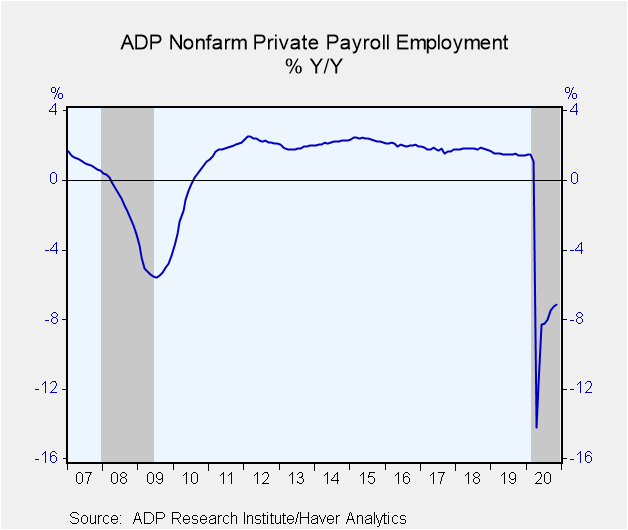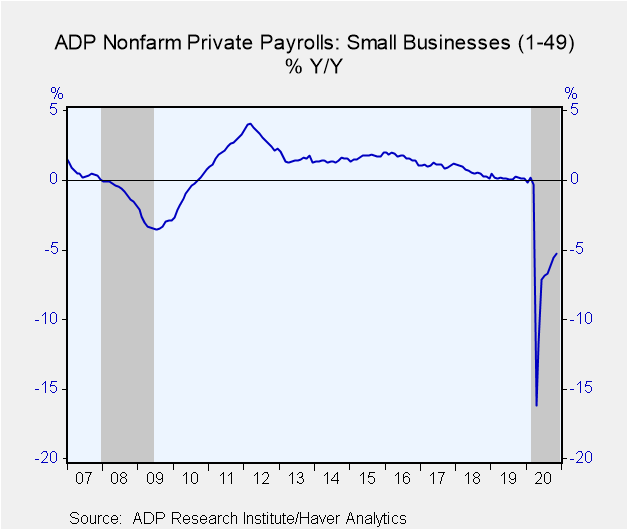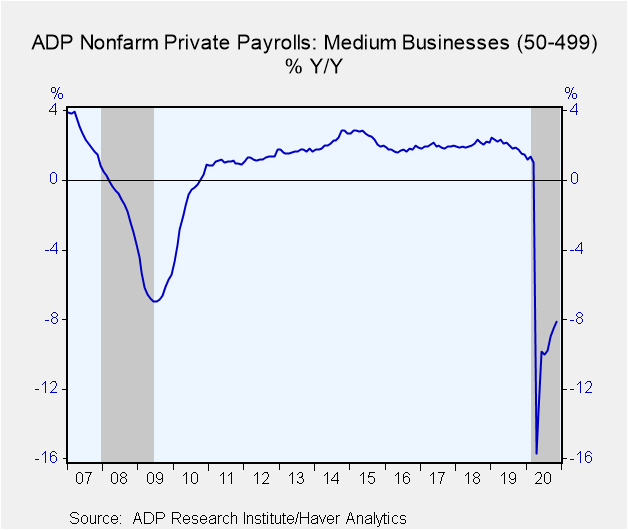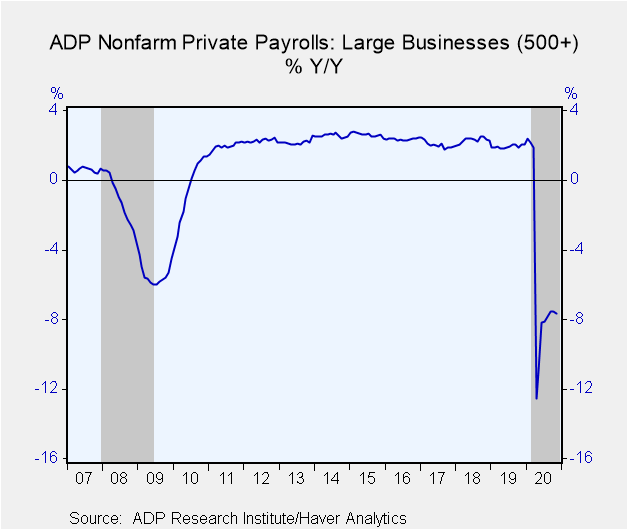 Global| Dec 02 2020
Global| Dec 02 2020U.S. ADP Nonfarm Private Hiring Slows During November
by:Tom Moeller
|in:Economy in Brief
Summary
• Job gain disappoints expectations. • Service-sector weakening is pronounced. The ADP National Employment Report indicated that nonfarm private sector payrolls increased 307,000 (-7.1% y/y) during November following a 404,000 October [...]
• Job gain disappoints expectations.
• Service-sector weakening is pronounced.
The ADP National Employment Report indicated that nonfarm private sector payrolls increased 307,000 (-7.1% y/y) during November following a 404,000 October rise, revised from 365,000. September payrolls gained 754,000, revised from 753,000. A 410,000 November increase had been expected in the Action Economics Forecast Survey. The ADP report is based on survey data through November 12.
Medium-sized payrolls improved 139,000 (-8.1% y/y) after increasing 154,000 during October, revised from 135,000. These gains compared to September's 247,000 increase. Small-sized payrolls rose 110,000 (-5.2% y/y) after improving 146,000 in October, revised from 114,000. Large payrolls increased 58,000 (-7.6% y/y) following a 104,000 October rise, revised from 116,000. It was the smallest increase since the beginning of the recovery.
Within industry sectors, private service employment rose 276,000 (-7.8% y/y) following a 382,000 gain, slowing from September's 555,000 increase. A 95,000 rise (-22.9% y/y) in leisure & hospitality employment led last month's increase following an upwardly revised 139,000 improvement. The number of education & health services jobs rose 69,000 (-4.1% y/y) after increasing 83,000 in October. A 55,000 gain (-5.9% y/y) in the number of professional business services jobs followed a 68,000 rise, revised from 60,000. Trade, transportation & utilities jobs increased 31,000 (-5.2% y/y) after a 59,000 improvement, revised from 53,000. Jobs in financial services rose 8,000 (-1.3% y/y) after a 7,000 October gain, substantially below September's 29,000 increase. Information sector payrolls held steady (-10.3% y/y) after edging 1,000 higher in October.
Employment amongst goods-producing firms strengthened 31,000 (-3.7% y/y) after October's 22,000 rise, revised from 17,000. During September, they were up by 199,000. The size of construction sector payrolls improved 22,000 (-1.7% y/y) following a 9,000 increase, after a 60,000 gain in September. Factory sector employment rose 8,000 last month (-4.6% y/y) after firming a little-changed 10,000 during October and 132,000 in September. Employment in the natural resource & mining sector edged 1,000 higher (-11.5% y/y), up for the fourth straight month.
The Automatic Data Processing Research Institute survey covers 411,000 companies and includes about one-fifth of U.S. private payroll employment. The data are processed by Moody's Analytics Inc., then calibrated and aligned with the BLS establishment survey data. The ADP data cover private sector employment only.
The ADP National Employment Report data can be found in Haver's USECON database. Historical figures date back to 2001 for private employment and the industry breakdown, and 2005 for the business size breakout. The expectation figure is available in Haver's AS1REPNA database.
| ADP/Moody's National Employment Report | Nov | Oct | Sep | Nov Y/Y | 2019 | 2018 | 2017 |
|---|---|---|---|---|---|---|---|
| Nonfarm Private Payroll Employment (m/m chg, 000s) | 307 | 404 | 754 | -7.1% | 1.5% | 1.8% | 1.7% |
| Small Payroll (1-49) | 110 | 146 | 203 | -5.2 | 0.2 | 0.6 | 1.1 |
| Medium Payroll (50-499) | 139 | 154 | 247 | -8.1 | 2.0 | 2.0 | 1.9 |
| Large Payroll (>500) | 58 | 104 | 304 | -7.6 | 1.9 | 2.3 | 2.0 |
| Goods-Producing | 31 | 22 | 199 | -3.7 | 1.6 | 2.9 | 1.8 |
| Construction | 22 | 9 | 60 | -1.7 | 2.7 | 4.1 | 3.7 |
| Manufacturing | 8 | 10 | 132 | -4.6 | 1.0 | 1.9 | 0.8 |
| Service-Producing | 276 | 382 | 555 | -7.8 | 1.5 | 1.6 | 1.7 |
Tom Moeller
AuthorMore in Author Profile »Prior to joining Haver Analytics in 2000, Mr. Moeller worked as the Economist at Chancellor Capital Management from 1985 to 1999. There, he developed comprehensive economic forecasts and interpreted economic data for equity and fixed income portfolio managers. Also at Chancellor, Mr. Moeller worked as an equity analyst and was responsible for researching and rating companies in the economically sensitive automobile and housing industries for investment in Chancellor’s equity portfolio. Prior to joining Chancellor, Mr. Moeller was an Economist at Citibank from 1979 to 1984. He also analyzed pricing behavior in the metals industry for the Council on Wage and Price Stability in Washington, D.C. In 1999, Mr. Moeller received the award for most accurate forecast from the Forecasters' Club of New York. From 1990 to 1992 he was President of the New York Association for Business Economists. Mr. Moeller earned an M.B.A. in Finance from Fordham University, where he graduated in 1987. He holds a Bachelor of Arts in Economics from George Washington University.










